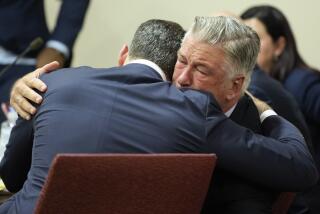Lawyer in Afghan murder case hopes to put the war on trial
- Share via
SEATTLE — John Henry Browne’s first brush with the U.S. military was during the Vietnam War. The lanky attorney, then a student who drove a purple hippie van, was rejected for the draft because he was too tall.
“I had done research, and I knew if you were over 6 foot 6 you were not qualified to go kill short people,” said Browne, who has a 1969 photo of himself in an Uncle Sam hat towering above a sea of fellow antiwar protesters. “So I’d done a bunch of yoga and stretched myself — and I got some help from some Quaker doctors — and I went in with a letter saying I was close to 6-7, which I was at the time.”
These days, Browne is preparing for another kind of encounter with the military, taking on the defense of Army Staff Sgt. Robert Bales, charged with murdering 17 Afghan civilians during a late-night shooting rampage in southern Afghanistan.
It surprised almost no one when Browne announced that he would put the Afghanistan war itself on trial. He flew to Ft. Leavenworth, Kan., to listen to Bales’ stories about the war and broke down weeping.
“It was quite emotional for all of us,” Browne said in a recent interview. “Bob Bales describing some of the things he’s witnessed in Iraq and Afghanistan, and some of the things he’s had to do: Picking up body parts from friends and putting them in bags,” he said. “You saw the movie ‘The Hurt Locker?’ It’s really a Disney movie compared to what Sgt. Bales told me.”
Browne, 65, has long since traded his 1960s-era long locks and droopy mustache for expensive, lawyerly overcoats, a trademark white scarf flung over the shoulder and carefully trimmed hair. He is also now one of the Northwest’s most prominent members of the defense bar, whose clients have included serial killer Ted Bundy and “Barefoot Bandit” Colton Harris-Moore.
He has won 17 not-guilty verdicts for murder defendants out of roughly 50 murder cases that have gone to trial. Only two clients in 30 years, he said, were convicted of first-degree murder — one of them, painfully, after he and his client proceeded to trial after rejecting a plea deal.
“Somebody asked me why I do this. I said, it’s because it’s my [flipping] path. It’s not romantic. This is one of the hardest jobs in the world to do well,” he said. “It sounds grandiose, and I don’t mean it that way, but I’m trying to get the system to work for Sgt. Bales.”
But the new case presents challenges even Browne has rarely had to face — countering forensic evidence gathered by military investigators from a nearly inaccessible village half a globe away; eliciting sympathy for Bales’ stressful combat deployments and previous brain injury from a panel of Army jurors; and playing the “put the war on trial” strategy to a U.S. Army tribunal.
“I do not think that will be a very productive theory to pitch to a panel of military officers and enlisted folks who have been over there three or four times,” said military defense attorney Phillip Stackhouse. “Because then, aren’t you almost putting them on trial?”
***
Browne has often won leniency for his clients by arguing that they were brain damaged, had troubled childhoods or were beaten by their husbands. He has a reputation for exhaustive trial preparation, combative pursuit of evidentiary motions, and careful strategizing that also leans heavily on the media.
In the Harris-Moore case, Browne’s team negotiated a nearly unprecedented agreement to consolidate roughly two dozen claims for prosecution across the country into a single set of charges, plus a federal case. Propelled by staff counsel Emma Scanlan, the defense prepared a heartbreaking “mitigation package” detailing Harris-Moore’s childhood ordeals.
Browne leaked it to the media two days before the sentencing hearing, creating a rash of sympathetic stories and preparing the public to accept the relatively lenient 71/2-year sentence handed down by the judge.
In a 2011 case, Browne sought to get a mistrial declared for a client charged with selling drugs at a casino by insisting that Kitsap County Superior Court Judge Theodore Spearman — who had made a series of unfavorable rulings — had “cognitive defects.”
“This trial has turned into a farce. F-A-R-C-E,” Browne declared in court. Browne refused to continue if Spearman didn’t get a mental evaluation, the judge threatened fines and incarceration, and the prosecutor protested that Browne was simply trying to get out of a trial he was about to lose.
“Call the jailers!” Browne declared.
It ended when a juror approached the bailiff and asked: “Will I get in trouble if I punch the defense attorney?”
“Mistrial,” sighed Spearman.
The judge died of a brain aneurysm a few months later — a fact that Browne now says proves he was right, and ethically bound, to challenge the judge’s mental functioning. “It had turned into a debacle,” he said. Kitsap County Prosecutor Russell Hauge, who insists the popular judge seemed fine, says it proves nothing. The defendant will be retried on the charges later this year.
Browne takes no responsibility for Bundy’s death sentence. The charismatic killer, executed in 1989 after confessing to 30 killings, rejected the plea deal Browne had negotiated for him and moved on to another attorney.
A memoir Browne is writing — tentatively titled “Music, Metaphysics and Murderers” (the music part will detail Browne’s days as a bass player for a band that opened for Jimi Hendrix and the Doors) — will include details of some 100 slayings the killer reportedly told him about.
“Ted Bundy’s going to be the most prolific mass murderer in the history of the world. What he told me he did, and gave me permission to talk about, is horrendous,” he said.
Browne went through his own form of post-traumatic stress as he was writing, he said, when he unearthed a note Bundy had left with a box of cookies. “‘Save one for me, Bunny,’ it said. That’s what he called me: Bunny. Talk about creepy.”
***
With Bales, Browne is powering forward with what looks to be a two-part strategy: One, he is challenging the Army to come up with a provable case, which so far, he says, it hasn’t, and may not be able to. And two, he’s planting seeds about the 38-year-old’s nightmares, foggy memory and traumatic war record in front of the public in case he needs to fall back on mental incompetence or, if it comes to that, a lenient sentence.
“Certainly for the prosecution this is not a slam dunk, in the sense that they have a body and an identified crime scene where the police showed up and secured the crime scene, they had the CSI people arrive and they collected forensic evidence. Browne is absolutely correct in that sense,” said Philip Cave, a retired Navy judge advocate who is now in civilian military practice.
On the other hand, he said, prosecutors probably have a video of Bales returning to the base, and they will have seized not only his weapon, but bullet fragments and cartridges collected at the shooting scenes.
“Let’s assume they got a reasonably decent chain of custody on the weapon and reasonably decent recovery on the cartridge cases, and identifiable bullet fragments. Then they match that to the weapon. Bingo,” he said.
And that may be where the old antiwar activist strides to the podium.
“There was a poll that came out two weeks after Sgt. Bales was arrested … the number of people opposed to the war rose 20 percentage points since this alleged incident. I think it’s up to 77-78% of the American people say, ‘What are we doing there? Let’s get the hell out,’” Browne told KIRO radio during a studio visit this month.
“I’ve met a lot of soldiers who are fighting a war that a lot of them don’t know why they’re there,” he said. “They don’t see the mission.”
More to Read
Sign up for Essential California
The most important California stories and recommendations in your inbox every morning.
You may occasionally receive promotional content from the Los Angeles Times.










